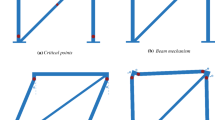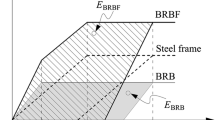Abstract
This study aims to optimize the weight of steel frames (as the objective function) to satisfy the legal constraints (inter-story drift and strength). The ultimate goal was to select an optimal arrangement and coordinate the two types of convergent bracing (multi-story X-bracing and X-bracing) in low, mid, and high-rise steel frames with specific dimensions and spans. In the end, an optimal weight design will be presented for the frames under the design constraints (by LRFD method), frequency, drift, and position of braces in frame height, and the amount of the tensile force of braces. Since the frequency constraints in design variables are highly nonlinear and non-convex, it is cumbersome to use them in optimization problems. In this research, the frames have been optimized using the connection between two software OPENSEES and MATLAB based on a multi meta-heuristic optimization algorithm with discrete variables (a new, mixed-method based on parallel island model with four islands). The findings of this research include the optimal position of braces, sections, and convergence history for the frames under a multi meta-heuristic optimization algorithm. The diagrams of convergence history were also provided for the particle swarm algorithm in mid-rise frames. The results show the superiority of the multi meta-heuristic search algorithm in the convergence speed and the quality of the optimal response compared to the particle swarm optimization algorithm. Optimizing with the multi meta-heuristic algorithm reduces the impact of parameters and the relations governing the operation. Finally, the optimal design is obtained. According to the results, the multi-story X-bracing frames (the combination of inverted V-Bracing and V-Bracing) have more optimized weight and, thus, better structural response than the X-bracing frames. Placing braces in the middle spans of frames and adjacent to each other was the optimal design and position for all frames.
























Similar content being viewed by others
References
Alhaddad, W., Halabi, Y., Xu, H., & Lei, H. (2020). Outrigger and belt-truss system design for high-rise buildings: A comprehensive review Part II—guideline for optimum topology and size design. Advances in Civil Engineering, 202, 30.
AISC. (2016). Specifications for structural steel building. American Institute of Steel Construction.
Andalib, Z., Kafi, M. A., Kheyroddin, A., & Bazzaz, M. (2014). Experimental investigation of the ductility and performance of steel rings constructed from plates. Journal of Constructional Steel Research, 103, 77–88.
ASCE. (2013). Minimum design loads for buildings and other structures.
Baghlani, A., Dehghan, F., & Ebrahimi Tavani, M. (2016). Optimization of bracing steel frames under frequency constraint. In: Paper presented at the first national conference on applied research in civil engineering (structural engineering and management management). Iran
Bazzaz, M., Kafi, M. A., Kheyroddin, A., Andalib, Z., & Esmaeili, H. (2014). Evaluating the seismic performance of off-centre bracing system with circular element in optimum place. International Journal of Steel Structures, 14(2), 293–304.
Bazzaz, M., Kheyroddin, A., Kafi, M. A., & Andalib, Z. (2012). Evaluation of the seismic performance of off-centre bracing system with ductile element in steel frames. Steel and Composite Structures, 12(5), 445–464.
De Stefani, L., Scotta, R., & Lazzari, M. (2015). Optimal design of seismic retrofitting of RC frames with eccentric steel bracing. Bulletin of Earthquake Engineering, 13(2), 613–633.
Erol, O. K., & Eksin, I. (2006). New optimization method, Big Bang-Big Crunch. Advances in Engineering Software, 37, 106–111.
Ghazi, A., Banan M. R., & Ashrafizadeh, M. (2003). Optimum design of space truss structures using parallel genetic algorithm. In: 6th International Conference of Civil Engineering. Iran.
Ghiasi, R., Fathnejat, H., & Torkzadeh, P. (2019). A three-stage damage detection method for large-scale space structures using forward substructuring approach and enhanced bat optimization algorithm. Engineering with Computers, 35(3), 857–874.
Ghiasi, R., Ghasemi, M. R., Binaee, Y., & Ghafari, H. R. (2016). Comparison of optimization metaheuristic algorithms in troubleshooting structures. In: Paper presented at the international conference on man, architecture, civil and city. Iran.
Goldberg, D. E., & Samtani, M. P. (1986). Engineering optimization via genetic algorithm. In Proc, 9th. Conf. Elec. Computations (pp. 471–482).
Hasançebi, O., Çarbaş, S., Doğan, E., Erdal, F., & Saka, M. (2010). Comparison of non-deterministic search techniques in the optimum design of real size steel frames. Computers and Structures, 88(17–18), 1033–1048.
Haupt, R. L., & Haupt, E. (2004). Practical genetic algorithms (2nd ed.). Wiley.
Hayalioglu, M., & Degertekin, S. (2005). Minimum cost design of steel frames with semi-rigid connections and column bases via genetic optimization. Computers and Structures, 83(21–22), 1849–1863.
Kalatjari, V. R., & Talebpour, M. H. (2011). Sizing and topology optimization of trussstructures by modified multi-search method. Journal of Civil and Surveying Engineering, 45(3), 351.
Kaur, P., Singh, M., & Josan, G. S. (2017). Comparative analysis of rank aggregation techniques for metasearch using genetic algorithm. Education and Information Technologies, 22(3), 965–983.
Kaveh, A., & Javadi, S. M. (2014). An efficient hybrid particle swarm strategy, ray optimizer, and harmony search algorithm for optimal design of truss structures. Periodica Polytechnica Civil Engineering, 58(2), 155–171.
Kaveh, A., Kalatjari, V. R., Talebpour, M. H., & Torkamanzadeh, J. (2013). Configuration optimization of trusses using a multi heuristic based search method. International Journal of Optimization in Civil Engineering, 3(1), 151–178.
Kaveh, A., & Talatahri, S. (2010). A noval heuristic optimization method charged system search. Acta Mechanica, 213, 267–286.
Kennedy, L. (1997). The particle swarm: social adaptation of knowledge. In: Proceeding of the IEEE international conference on evolutionary computation (pp. 303–308).
Kumar, G. R., Kumar, S. S., & Kalyanaraman, V. (2007). Behaviour of frames with non-buckling bracings under earthquake loading. Journal of Constructional Steel Research, 63(2), 254–262.
Lieu, Q. X., Do, D. T., & Lee, J. (2018). An adaptive hybrid evolutionary firefly algorithm for shape and size optimization of truss structures with frequency constraints. Computers and Structures, 195, 99–112.
Miki, M., Hiroyasu, T., Kaneko, M., & Hatanaka, K. (1999). A parallel genetic algorithm with distributed environment scheme. In: Paper presented at the IEEE SMC'99 conference proceedings. 1999 IEEE international conference on systems, man, and cybernetics (Cat. No. 99CH37028).
Moghdam, H. (2019). Optimization of steel frames with rigid joints using particle swarm optimization (PSO) algorithm. In: 3rd international conference on applied researchers in structural engineering and construction management.
Mohammadhosseini, M., & Ghadiri, H. (2019). A combination of genetic algorithm and particle swarm optimization for power systems planning subject to energy storage. Journal of Computer and Robotics, 12(1), 65–76.
No.10, C. (2013). Design and execution of steel structures, (4th edition). Office of National Building standards. National building regulations of Iran, Ministry of Housing and Urban Development.
Park, C. W., & Kang, M. M. (2002). Discrete optimum design of space truss structures using genetic algorithms. Architectural Research, 4(1), 33–38.
Paz, M., & Leigh, W. (2004). Structural dymamic (5th ed.). Massachusetts: Kluwer Academic Publishers.
Rajan, S., & Nguyen, D. (2004). Design optimization of discrete structural systems using MPI-enabled genetic algorithm. Structural and Multidisciplinary Optimization, 28(5), 340–348.
Ramly, N. (2018). Improvisation of fuzzy c-means method and fuzzy linear regression model in predicting manufacturing income. Universiti Tun Hussein Onn Malaysia.
Rosenblueth, E. (1986). Optimum reliabilities and optimum design. Structural Safety, 3(2), 69–83.
Safari, D., & Maheri, M. R. (2006). Genetic algorithm search for optimal brace positions in steel frames. Journal of Advanced Concrete Design, 2(4), 400–415.
Saka, M., & Kameshki, E. (1998). Optimum design of multi-storey sway steel frames to BS5950 using a genetic algorithm. Advances in Engineering Computational Technology, 135–141.
Sardari, F., Dehkordi, M. R., Eghbali, M., & Samadian, D. (2020). Practical seismic retrofit strategy based on reliability and resiliency analysis for typical existing steel school buildings in Iran. International Journal of Disaster Risk Reduction, 51, 101890.
Shinde, S. S., Galatage, A. A., & Kulkarni, D. S. K. (2017). Evaluation seismic efficiency of combination of bracing for steel building. In: IJARIIT, ISSN, 46–55.
Talebpour, M. H., & Kalatjari, V. R. (2014). Optimization of structures by combinatorial meta-heuristic methods. Ph.D. Thesis, Shahrood University of Technology.
Tanimura, Y., Hiroyasu, T., & Miki, M. (2001). Discussion on distributed genetic algorithms for designing truss structures.
Weihmann, L., Martins, D., de Andrade Bernert, D. L., & dos Santos Coelho, L. (2012). Optimization of kinematically redundant manipulators force capabilities using improved harmony search. In: Paper presented at the ABCM Symposium Series in Mechatronics.
Xie, Q. (2005). Dual system design of steel frames incorporating buckling-restrained braces. In: Paper presented at the fourth international conference on advances in steel structures.
Yang, S., Yan, L., & Qi, C. (2019). An adaptive multi-step varying-domain topology optimization method for spot weld design of automotive structures. Structural and Multidisciplinary Optimization, 59(1), 291–310.
Zhang, Y., Zhou, X., & Shih, P.-C. (2020). Modified Harris Hawks optimization algorithm for global optimization problems. Arabian Journal for Science and Engineering, 45(12), 10949–10974.
Author information
Authors and Affiliations
Corresponding author
Ethics declarations
Conflict of interest
I as a corresponding author assert that our scientific group did not receive payment or services from a third party (government, commercial, private foundation and etc.) for any aspect of the submitted revised work. I disclose that there is no actual or potential conflict of interest including any financial, personal or other relationships with other people or organizations within three years of beginning the submitted revised work.
Additional information
Publisher's Note
Springer Nature remains neutral with regard to jurisdictional claims in published maps and institutional affiliations.
Rights and permissions
About this article
Cite this article
Mohajer, A., Kalatjari, V. & Talebpour, M. Optimization of Location, Topology and Number of Bracing Spans in Steel Structures Using Multi Meta-Heuristic Based Search Method and Dynamic Constraints. Int J Steel Struct 22, 112–133 (2022). https://doi.org/10.1007/s13296-021-00563-1
Received:
Accepted:
Published:
Issue Date:
DOI: https://doi.org/10.1007/s13296-021-00563-1




